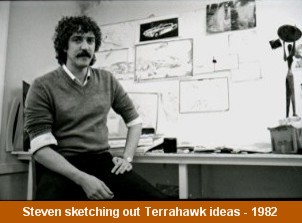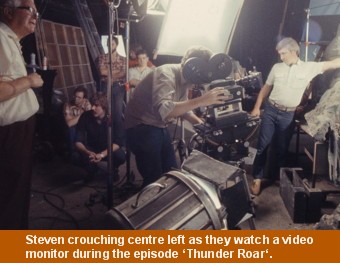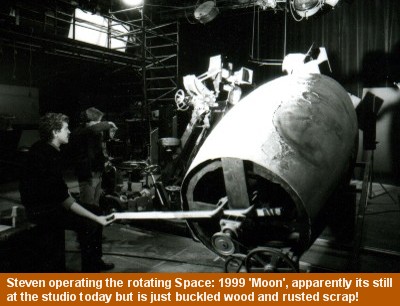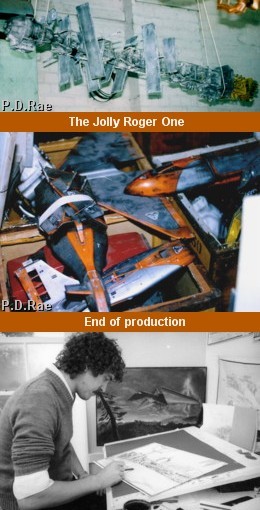 |
Terrahawks
SFX. Behind The Scenes Special - 2 By David Sisson |
 |
Terrahawks
SFX. Behind The Scenes Special - 2 By David Sisson |
|
|
| I got the
award from Bernard Wilkie who was an extremely nice man;
he was the head of the BBC's visual effects department at
the time and said that I would easily get a job in their
department - anytime! When I applied through the proper lines to do that I was rejected as I didn't have a degree in anything, which I thought was rich coming from a group who were, I felt, the benchmark in the worst VFX anyone had seen at that time! Anyway thanks to Bernie. |
 |
David:
How did you first meet Gerry and get a job on the Terrahawks
production. Did you hear about the job and apply? Steven: I knew Phil Rae and he was involved in setting up a Gerry Anderson exhibition in Blackpool. Phil tipped me off that Gerry would be visiting and so I gathered up my 16mm films and traipsed off down there from Edinburgh. I showed one of my films and Gerry said he had already seen it, which surprised me. Anyway he seemed impressed and said keep in touch, which I did, probably to the point of annoying him. A year later I get a call from him saying can you storyboard? And can you send me some examples ASAP? I had done crude one's for my own stuff, but nothing I was proud of, so I spent two long nights churning out boards at the highest quality I could manage for imaginary action shots which I sent to him and he liked. |
| David:
So you were originally hired to do design &
storyboard work? How long did this go on for? Steven: I storyboarded and designed for a quite a few weeks (I was delirious) till Ian Scoones started. My style of art on the boards was heavily influenced by concept designer Joe Johnson's art on the first three 'Star Wars' films, which was ink and marker. Funnily enough I've just spent the last two years working as VFX supervisor on 'The Wolfman’, which was directed by Joe. Anyway my take on the craft and hardware kind of ended when Scoones came on board. |
 |
 |
David:
Your pre-production designs for the craft seemed to
be better than the final designs used - the Battlehawk
for instance seemed much rounder and nicer looking - how
were the final designs arrived at? Steven: At the time the craft were being built Ian Scoones was in charge, so I didn't really have any say in how my designs where interpreted. The Battlehawk was the biggest letdown for me personally, as I'd drawn the thing as being very rounded and curvy. Gary Tompkins, the art director, drew it up as angular and Ian Scoones then chose the colour scheme. The only redeeming factor was John Lee and Steve Woodcocks panelling and detailing. This went for all the other craft to a degree. The first vehicle I had any real say in was the Overlander, as I had taken over as SFX Director by then. There was a mooted third series of Terrahawks, as it was very popular on ITV at the time getting 7 - 10million viewers, and I talked Gerry into starting the first new episode with the old Battlehawk being destroyed and then a new rounder mark II version based on my designs replacing it. Unfortunately Christopher Burr decided not to finance that series.... Bugger! David:
I heard a story that the Battlehawk was supposed to be on
a launch platform, which raised it up into its vertical
take-off position? David:
Mark Harris said that the Battlehawk hanger had been
entirely lined with metal sheeting, was this because you
were planning to have big flame effects coming out of the
vehicle as it launched? David:
Did you have any input into the basic concept of the show
- Were you involved with coming up for ideas on how the
craft were launched? David:
How was that Hawkwing launch shot actually done? David:
What did you think when Gerry offered you the job as SFX
Director! David:
Had much been filmed before this happened, as you did get
the credit as SFX Director from episode one. |
 |
| David:
What was the experience of the people surrounding you, as
many seemed to be new starters like yourself. I
recognized Harry Oakes as one of the old timers and I
believe that Malcolm King had been in the business quite
a while. Did they advise you? Steven: Harry became a good friend and I constantly grilled him about how things were done in the past, e.g. what speed did they shoot the SHADO Mobiles? I learned a hell of a lot from him. Malcolm I had a few run-ins with, mainly about the look of the pyro effects (explosions). I wanted the classic ‘Century 21’ bangs. He went the ‘Space: 1999’ route of having too much magnesium and titanium in the mix. We experimented with Iron filings and then we started getting what I wanted when I would dress rubber dust (coloured dust derived from the shavings of tyre remoulds, used for set dressing) on the top of his pyro. It was highly inflammable when airborne and would create a nice orangey-red fireball! Years later that's the very same mix for the train explosion at the end of 'Batman Begins'! |
 |
 |
David:
Although classed as the ‘Director’ there are
pictures of you holding the models support wires during
the filming, setting up the shot or operating the camera.
Were you very ‘hands on’ - wanting to do every
job? Steven: Extremely, including painting the backings. This led to me getting a job with Derek Meddings years later, were I did pyro, painted backings, etc with him. David: Terrahawks
was made in 16mm, did this present you with any problems?
Or did it have advantages. I’m just wondering if the
prospect of using 16mm was less daunting to you with your
previous experience than say jumping straight into using
35mm cameras. David:
'Space: 1999' rather famously utilized the
multiple-exposure technique for many of its special
effects. You copied this but seemed more willing to push
it to its limit – you didn’t seem scared of
over-lapping images. David:
Did you feel an added pressure of audience expectation,
in that you were working on a Gerry Anderson production,
something that would be compared to 'Thunderbirds'
and 'Space: 1999'. David:
Not only that though, Terrahawks was
also made at a time when Sci-Fi and special effects were
suddenly big business in Hollywood. You now had 'Star
Wars/Battlestar Gallactica' effects to try and match
up to in episodes like ‘First Strike’
! David:
Was there much contact with the puppet department? David:
Did you get involved with operating the full-sized
Zeroids? |
 |
 |
David: Was it tricky working with the very small Cubes and Zeroids? Steven: The Zeroids where easy (they were just EMA spheres) and fun, the cubes less so, as its kind of hard to animate a box! I thought the Zeroids could have had a show all of their own and I know that Gerry seriously considered it. We used wires to move them, also blowing/throwing them, stop-motion and sometimes running the camera in reverse. The whole Zeroid gag was based on the bouncing spheres that appeared in ‘The AB Chrysalis’ episode of 'Space: 1999'. David:
You used stop-motion in some of the other shots –
manipulator arms on vehicles, the wing tips of Hawkwing,
etc. Is this a technique that you were a fan of? David:
What sort of camera film speeds were you using? David:
So how many cameras did you have access to? And was there
an average number of effects shots that you had to
achieve per day? David:
While many of your space explosions done with a
simple straight cut from a spaceship to an explosion,
some of your later ones (examples - 'The
Ultimate Menace', 'Jolly Roger One') featured
electrical discharges, mini-glowing flares and then what
appears to be an over-lapped explosion(s) that I could
only imagine being done on an optical printer. How did
you do such an effect in-camera? David:
The model making on the show was of a very high quality.
I believe that all the model building work was done
in-house (Apart from Spacehawk built by Philip D. Rae)
unlike past shows that had outside contractors. David:
The Overlander was a brilliant design, very ‘Thunderbirds’
like. David:
Did you design the figure in the gardens that was
actually the Radio-Telescope – I thought that was a
really neat design! David:
Was there a size limit on the models – they did
sometimes seem smaller than some of the models used on
past shows. Was there a certain scale that you worked at?
David:
Spacehawk was the first craft to be built for the series.
Apparently a rush job built in time for the arrival of
the Japanese investors. Although an interesting design it
wasn’t really designed for use in the series like
the other vehicles. Did this give you problems - like
wheres the docking ports? It must have given you a
headache when the scripts suddenly called for it to
'land' on a moon or planet - something that it simply
wasn't built to do. David:
The nightime cityscapes looked rather good, even though
there didn’t seem to be many model buildings –
was it mostly done using backlit artwork or something? |
| David:
Was the barrel moon/planet the same as that used on 'Space:
1999'? Steven: Yes it’s the barrel moon from ‘1999’. There were loads of artifacts lying around in Bray studios from that show when we arrived to do Terrahawks. A close-up Eagle section (which became the close-up of the Treehawk bay on the Spacehawk, yes I know its sacrilege), and loads of huge black and white lunar landscape cut-outs. David: Was
there ever something that you could never get to work? I know Derek Meddings hated it too and that is why he lumbered Peter Wragg with the more boring flying stuff on ‘Thunderbirds’. I moved heaven and Earth to get a motion control rig on this show but it died before that happened. |
 |
 |
David:
Battletank was, I believe, the first Gerry Anderson
‘Hero’ craft to be operated using
radio-control, did this ever present a problem? Steven: No, not at all. I don't remember any problems other than constantly having to change its batteries. David:
There was a different Battletank design in the episode 'A
Christmas Miracle' with the addition of a gun
turret. Was this in the script or just your idea to
improve the tank design? David:
Were the Megazoids supposed to be able to come out of the
Battletank? It was blown up in one episode (Terratomb)
and I kept thinking why didn’t they get out! David:
You did several illustrations of the hook design on
the Battletank and its use to recover the vehicle and
winch it back into the Battlehawk. These were published
in several magazines but it was never featured in the
series. Did you ever try to film this sequence? David:
That was the very small model, the problem being that it
had no suspension system. From the fifth episode (Close
Call) you switched to bouncing the big model in
front of camera – which was one of my favourite
shots in the series. David:
Who was inside the giant Sporilla suit - was that someone
in your department? David:
Your effects shots certainly improved rapidly as the
series progressed. The White House model for instance
looked rather small in the opening episodes, yet without
changing the model you were able to make more believable
shots. David:
Were there any other model designs during the series that
stood out or pleased you. The Space Tank was rather
impressive and seemed to have the same Overlander
chassis. And the ZEAF also seemed to suddenly appear and
become a very major craft - pretty much replacing the use
of all the other ships in Zelda’s fleet! |
 |
 |
David:
What did you think of the finished program at the time? Steven: Mainly, I just wish the puppets had been better realized, the show was very camp and if we'd gone with Martin Bower's original take on the characters (i.e. sexy as hell females for example) I think it would have been a classic. I know the show was derided by many, but I was very proud of the show in many ways as it was my big break. Although it alienated me from a lot of the older effects guys who had earlier come through the same gates with Gerry - with the big exception of Derek Meddings, which says a lot. They went out of their way to stir things up with the Union, which was quite strong at the time. They forgot they had all had similar breaks at Century 21 and didn't like the idea of a newcomer stealing their thunder. David:
Has your opinion changed now? David:
When you look back at the various jobs that you have done
to date, TV shows and major feature films, where does Terrahawks
come out purely on the enjoyment level. Hard work
obviously but was it one of the good times? David: Thank you very much for your time Steven. BACK TO INDEX ........... or ........... Back to INTERVIEW SELECTION |
Many thanks to
Philip D Rae for the use of his colour behind-the-scenes
photographs.
Other photographs by
Anderson Burr Pictures Ltd.
'Terrahawks'
is copyright by Christopher Burr - No infringement
of copyright is intended - non-profit fan interest site only.
'Terrahawks' is a Gerry Anderson and Christopher
Burr Production.
David Sisson 2010